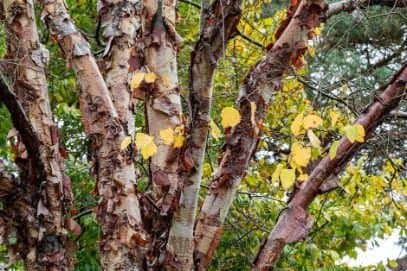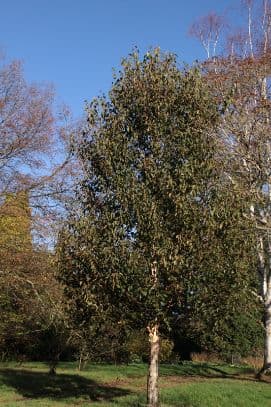European hornbeam Carpinus betulus

ABOUT
Commonly known as the European hornbeam, this plant is recognized for its graceful and well-structured appearance. It is characterized by a smooth, gray bark that looks like it has vertical muscles, giving the tree a distinctive look that is appealing in landscapes. The leaves are decidely deciduous, with each leaf exhibiting a rugged texture with prominent veins, and they are typically oval-shaped with a pointed tip and serrated edges. During the spring and summer, the foliage presents a vibrant green hue, which transitions into a range of yellows and sometimes oranges or reds in the fall, offering a seasonal display of colors. The European hornbeam produces catkins, which are long, slim clusters of flowers that can be seen in the spring. These catkins add to the ornamental value of the plant during the flowering season. Following the flowers, small, greenish fruit clusters appear. They are in the form of small nuts partially enclosed by leafy, 3-lobed bracts, which gradually mature as the seasons progress, providing food for wildlife. Despite the omission of its physical dimensions, its form is typically symmetrical, creating a neat and tidy canopy that is dense with foliage, making it popular for use in hedges and topiary, as well as a standalone specimen due to its pleasing aesthetic features.
About this plant
 Names
NamesFamily
Betulaceae
Synonyms
European Hornbeam, Common Hornbeam, Hornbeam
Common names
Carpinus betulus f. betulus, Carpinus betulus var. betulus.
 Toxicity
ToxicityTo humans
The Carpinus betulus, commonly known as the European hornbeam, is not considered toxic to humans. There are no well-documented reports of toxicity from ingesting any part of this plant. Therefore, accidental consumption is not expected to lead to poisoning or serious health consequences.
To pets
The European hornbeam is also not considered toxic to pets. There is no notable risk of poisoning if pets accidentally ingest parts of this plant. Hence, it is generally considered safe in gardens and areas where pets might have access to it.
 Characteristics
CharacteristicsLife cycle
Perennials
Foliage type
Deciduous
Color of leaves
Green
Height
40-70 feet (12-21 meters)
Spread
30-40 feet (9-12 meters)
Plant type
Tree
Hardiness zones
4-8
Native area
Europe
Benefits
 General Benefits
General Benefits- Ornamental Appeal: Carpinus betulus, commonly known as European hornbeam, adds ornamental value to landscapes due to its attractive foliage and symmetrical growth habit.
- Shade Provision: With its dense canopy, it provides ample shade in gardens, parks, and streets, making it an excellent choice for creating cool, shaded areas.
- Wildlife Support: The tree supports wildlife by providing habitat and food sources, such as nuts for birds and small mammals.
- Soil Erosion Control: Its extensive root system can help stabilize soil and control erosion, especially on slopes or in areas prone to soil loss.
- Seasonal Interest: European hornbeam features bright green leaves in spring, which turn golden yellow in the fall, offering seasonal interest in the landscape.
- Windbreak: The dense foliage and strong structure make it suitable for use as a windbreak or hedge, helping to protect against strong winds.
- Durability: It is known for its hard wood and ability to withstand pruning and shaping, making it ideal for topiaries and formal gardens.
- Sustainable: The tree's longevity and adaptability contribute to sustainable landscaping as it requires minimal maintenance once established.
 Medical Properties
Medical Properties- This plant is not used for medical purposes.
 Air-purifying Qualities
Air-purifying QualitiesThis plant is not specifically known for air purifying qualities.
 Other Uses
Other Uses- Carpinus betulus, commonly known as European hornbeam, is used in parquet flooring due to its hardness and durability, giving an aesthetically appealing grain and resilience to wear.
- The wood of European hornbeam is ideal for making piano actions, which are the mechanical parts of a piano that transfer the motion of the keys to the hammers.
- Due to its fine grain and resistance to splitting, the wood is often used for carving detailed figures and intricate sculptures.
- Wood from the European hornbeam is valued for woodturning, being prized for the creation of bowls, ornaments, and other decorative items that require a smooth finish.
- European hornbeam is popular for making tool handles, especially for tools requiring tough, shock-resistant handles like hammers and axes.
- The wood is suitable for constructing the wooden cogs of windmill and watermill machinery, capitalizing on its strength and ability to endure the stresses involved in mill operations.
- In musical instrument construction, European hornbeam is sometimes employed for wind instruments and parts requiring precision and strength.
- The density of European hornbeam makes it an excellent choice for making mallets and wooden hammers used by woodworkers and carpenters.
- Eco-friendly dyes are extracted from the bark and leaves, though not widely used commercially, these provide an array of colors for small-scale or traditional fabric dyeing processes.
- Joiners and cabinetmakers historically used hornbeam in furniture making, especially in areas that required tough, wear-resistant wood such as chair arms and table legs.
Interesting Facts
 Feng Shui
Feng ShuiThe European hornbeam is not used in Feng Shui practice.
 Zodiac Sign Compitability
Zodiac Sign CompitabilityThe European hornbeam is not used in astrology practice.
 Plant Symbolism
Plant Symbolism- Resilience: Carpinus betulus, also known as the European hornbeam, is known for its sturdy wood and ability to withstand strong winds and even pollution, symbolizing resilience and endurance through challenging conditions.
- Stability: The strong, dense wood of the hornbeam, which was historically used to make yokes for plough animals, suggests stability, reliability, and a grounded nature.
- Longevity: With its potential to live for centuries, the hornbeam is often associated with longevity and timelessness.
- Flexibility: Despite its hardness, Carpinus betulus wood is also quite flexible. This characteristic symbolizes the balance between strength and adaptability.
- Renewal: The deciduous nature of the hornbeam, shedding leaves in autumn and budding anew each spring, represents renewal and the cyclical nature of life.
 Water
WaterThe European hornbeam prefers consistently moist soil, so it is important to water the tree deeply when the top 2 inches of soil feel dry to the touch. Established European hornbeam trees should be watered every 7 to 10 days, applying about 1.5 gallons for every inch of trunk diameter at breast height. During hot or dry periods, increase the frequency of watering to prevent stress. Young or newly planted trees require more frequent watering, about once or twice a week, ensuring that the soil is moist but not waterlogged.
 Light
LightThe European hornbeam thrives in full sun to partial shade conditions. The ideal spot would receive at least four to six hours of direct sunlight daily but can also benefit from some afternoon shade, especially in hotter climates. This adaptable tree can handle some variation in light levels, but for the best growth and form, a spot with a good amount of daily sunlight is preferred.
 Temperature
TemperatureThe European hornbeam is hardy and can withstand a wide range of temperatures; it performs best when the average temperature falls between 65°F and 75°F. This tree can survive minimum winter temperatures down to -20°F and is suitable to grow in USDA hardiness zones 4 through 8. It is important to avoid extremely high temperatures over 95°F for extended periods, which can stress the tree.
 Pruning
PruningPrune the European hornbeam in late winter or early spring before new growth starts to shape the tree, remove any damaged or diseased branches, and encourage a strong structure. Pruning can be done annually or as needed to maintain the desired shape. The best time to prune mature trees is when they are dormant to prevent stress and avoid the spread of tree diseases.
 Cleaning
CleaningAs needed
 Soil
SoilEuropean hornbeam thrives in a well-draining loamy soil mix with neutral to slightly alkaline pH levels, ranging from 6.0 to 7.5. Amend the soil with organic matter like compost to improve texture and nutrient content.
 Repotting
RepottingEuropean hornbeam trees, being large landscape trees, do not require frequent repotting. Instead, young trees may be repotted or transplanted every few years until they reach a mature size and are planted in their permanent location.
 Humidity & Misting
Humidity & MistingEuropean hornbeam tolerates a wide range of humidity levels but prefers average to high humidity conditions typical of outdoor environments; it does not usually require specific humidity adjustments.
 Suitable locations
Suitable locationsIndoor
Not ideal for indoor growth; requires ample space.
Outdoor
Plant in well-draining soil, full sun to partial shade.
Hardiness zone
4-8 USDA
 Life cycle
Life cycleEuropean hornbeam (Carpinus betulus) begins its life cycle as a seed, typically dispersed by wind due to its small, papery bracts aiding in wind dispersal. Upon germination, which is favored by moist, cool conditions, the seedling emerges and begins to establish a root system. As a juvenile, it develops into a young sapling, steadily growing in height and girth, with leaves that exhibit its characteristic serrate margins. The sapling matures into an adult tree, developing smooth gray bark and a characteristic fluted trunk, with branches that bear catkins, the tree's inflorescences, in early spring. Pollination occurs primarily by wind, leading to the development of small, nut-like fruit that are once again dispersed by wind or sometimes through animal actions. The mature European hornbeam can live for hundreds of years, completing its life cycle upon death, which contributes organic matter back to the ecosystem and potentially provides habitat for various wildlife species.
 Propogation
PropogationPropogation time
Spring-early summer
The most common name for Carpinus betulus is European hornbeam, and the most popular method of propagation for this species is by seed. Propagation time by seed typically begins in the fall, just after the seeds have matured and are harvested. To propagate European hornbeam by seed, one first needs to stratify the seeds to overcome dormancy; this is done by mixing the seeds with slightly moist sand and storing them in a refrigerator at approximately 34 to 41 degrees Fahrenheit (1 to 5 degrees Celsius) for 2 to 3 months. After stratification, the seeds should be sown in a well-draining seedbed or containers filled with a mixture of loam, sand, and peat, with a depth of about 1 to 2 inches (2.5 to 5 cm). Germination can be slow and irregular, but once seedlings emerge and reach a suitable size, they can be transplanted into individual pots or into their final growing position outdoors.





![Silver birch [Fastigiata Joes]](/_next/image?url=https%3A%2F%2Fplants-admin.emdemapps.com%2Fimages%2Fplants%2F%2Fimages%2F604b6438424d4.png&w=640&q=75)



